Bread Baking Technique #9 - Baking Stones, Pizza Stones and Steam In The Oven
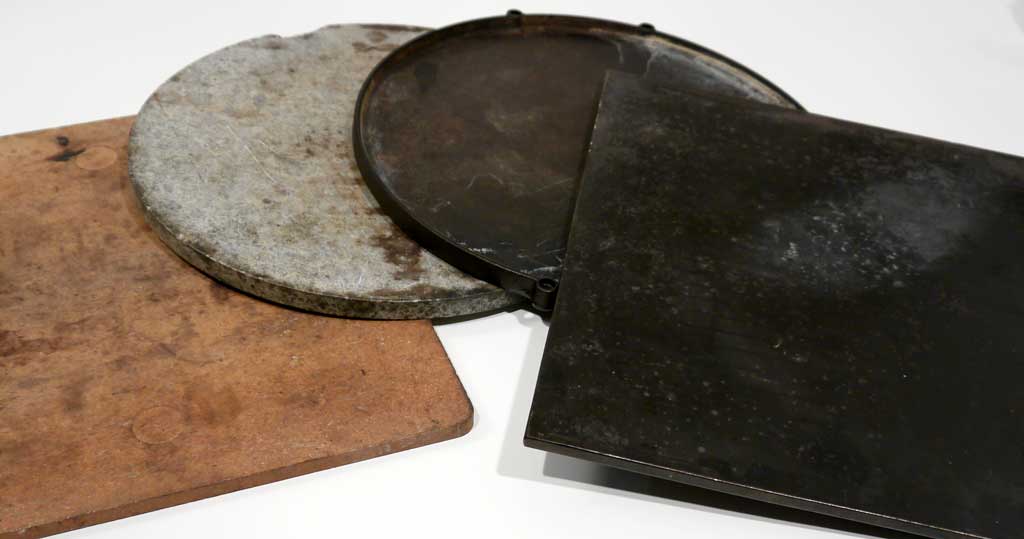
Home and Professional Oven Differences
Pizza Ovens and wood-fired ovens
These types of ovens can naturally be used for making pizzas, but they are also very suitable for baking breads with a robust wet dough. They can generally reach a temperature of between 300°C and 600°C (570°F and 1110°F).
Professional pizza ovens in a pizzeria can typicall reach about 300 degrees, and are covered on the inside with stones.
Firewood and charcoal-fired ovens are usually made entirely of stone, and typically reaches 500°C - 600°C (930°F - 1110°F).
There is a lot of mass in the stones, which can store a lot of heat. The heat is also transferred relatively quickly from the stones through the air.
This means that, for example, a pizza can be baked in about 2-5 minutes.
Home Oven
Most home ovens can reach 250°C (480°F). A few can reach 300°C (570°F). I have read that one can tinker with pyrolysis settings so that they can reach 600°C (1110°F) and make pizza at that temperature. But I seriously doubt that it is good for the oven in the long run.
So a home oven cannot reach the same temperature as a pro-oven. Which is one of the reasons that it can be difficult to make good bread at home.
Oven capacity
Professional ovens run at 400 volts and use three phases. They are generally able to produce 27kW of power.
Home ovens running at 230 volts in Europe, can typically provide 2-3 kW of power.
Pizza and pro ovens can therefore pump 10 times as much power, and thus heat, into their heating chambers. So even if you open the door and some cold air rush into it, it does not matter much. The combination of the heavy stone in the oven and the abundant power do that they hold their temperature very well.
Bakery ovens does typically not use stones. They just have lots of power, which keeps the temperature stable.
Steam
Another difference between pro- and home- ovens is that the pro ones can run steam into the oven. The steam typically transfers heat ten times as efficiently as hot air. So the bread is more quickly heated up.
The steam also prevents the drying up of the surface of the dough. Which does that the bread can raise even more. The steam also adheres to the surface of the dough and give it the shiny, smooth and crunchy surface, known from the bakers bread. Therefore, it is hard to make as crisp a bread in a home oven.
Pizza and stone ovens typically do not use steam. Therefore, the loaves from such ovens have a deeper, rougher and tougher crust. And are not glossy.
Convection / hot air
Bakery Ovens circulates the air in the oven so that the temperature is uniform throughout the oven. Virtually every home oven has convection these days.
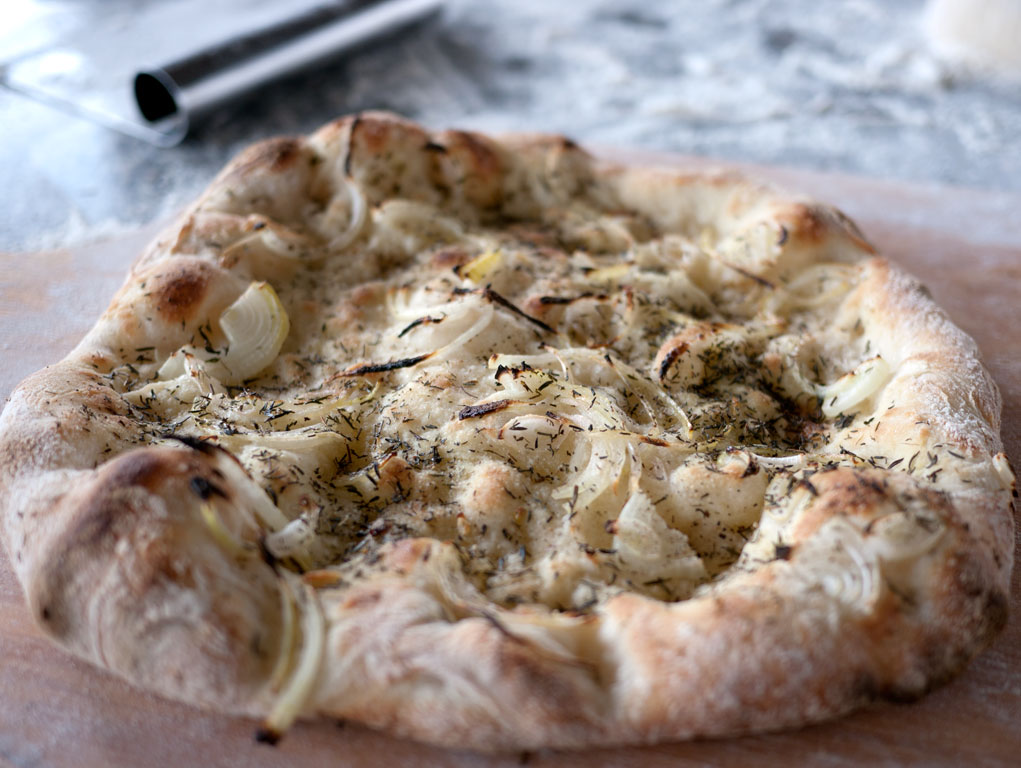
The solution
All right. It does seem pretty bleak for the avid home baker. The oven cannot become hot enough. It cannot keep the temperature, and it cannot make steam.
Luckily, there is a good combination of options that solves all the problems.
It is not necessary to have a burning hot oven. What counts is having a lot of heat and to get that heat into the bread as quickly as possible.
In the table below you can get a sense of how well different materials conduct heat.
The table is far from conclusive and not very precise. So consider it just a rough guideline I have pieced together some heat transfer coefficients from different sources ,to give an idea of various materials thermal conductivity.
The thermal conductivity of some relevant materials
- Air: 0025
- Water: 0.6
- Brick: 1
- Granite: 3
- Marble: 3
- steam: 10
- Steel: 45
- Cast: 55
- Aluminum: 220
- Copper: 370
Air is a relatively poor heat transfer media. Although it does gets a little better when the air is circulated in the oven. This why you should typically lower the temperature of the oven by 10% when using convection, compared to a conventional heating.
Surprisingly, stone and stone slabs are not particularly good conductors. Although they are a lot better than air.
When you look at the list it seems relatively obvious that aluminum, which is a "relatively" inexpensive material that has a super thermal conductivity, could be used as a a good baking "stone". But ...
Weight of the baking stone
If one considers a baking stone to be a battery for heat, the amount of heat it can store is dependent on the weight of the stone. The heavier the baking stone the more heat it can store.
Aluminum has the disadvantage that it does not weigh very much. So you'll need a fairly thick slab of aluminum plate. Aluminum then becomes relatively expensive. Copper is very heavy, and has a truly breathtaking maximum thermal conductivity. So it should be the perfect material. And if you can afford to make a baking stone of copper, please do tell me how it turns out :-S
Material weight in kg/cubic meter
- Water: 1000 (for comparison)
- Marble: 2563
- Aluminium; 2600
- Granite: 2691
- Iron or steel: 7850
As you can see then iron and steel have equal weight. And is 2-3 times as heavy as the other materials typically used for baking stones.
In my experience, an iron or steel baking stone is the best compromise between weight, price and thermal conductivity for a baking stone.
My experience / baking stone I have - and have tested.
I have tried out various baking stone during the last 10-15 years. So here is my experience with them.
Square pizza stone for the oven
2.7 kg, ceramics. Reminiscent of an unglazed terracotta tile.
This was my first pizza / baking stone. I used it for some years, and occasionally it resulted in some fine bread.
It was an improvement compared to a conventional baking tray, but not a revolution. I was never quite happy with it. Nor quite disappointed:-S
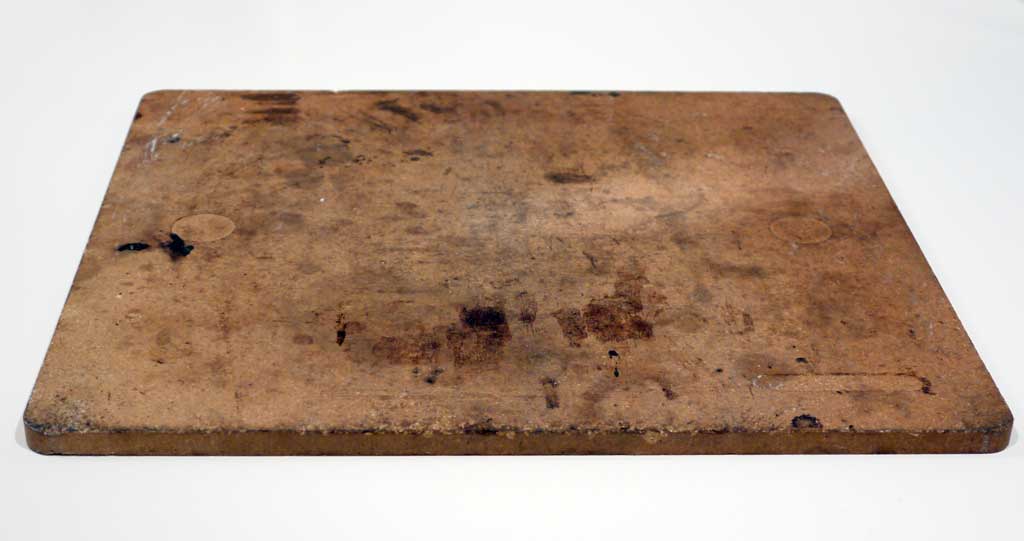
Round pizza stone
4.3 kg, compacted granite
I came back, happy, from a vacation in the southern europe after having had pizza baked over a charcoal grill. The structure and taste was most excellent. I naturally got the idea that I wanted to make pizza in my charcoal grill, and maybe even bread. We are 5 in the family, so we usually eat 3-4 large pizzas for a meal.
As soon as you open your grill, the heat disappears from the inside. But the stone, that is heated by charcoal, can be up to 500°C - 600°C (930°C - 1110°C) (very hot). So it always ended up with the first pizza being good, the rest of them were burned on the bottom and raw on top. There is probably some barbecue enthusiasts that can get it to work. I was never happy with it though.
Outside the grill, in the oven, the round stone is of little use for baking bread because it is round. For instance it is hard to make more than 1 baguette or french bread at a time.
So this stone I never use anymore.

Round "pizza stone" cast iron
3 kg, cast iron
I got the idea that metal was a better material when it came to transferring heat in your home oven. So I had plans to cut my own from hot rolled steel. Then I found this stone in my local hardware store. I thought it would be an easy way to test my metal stone theory.
It turned out that I was right. Cast iron is excellent! The only problem with it was that it was round. So like the round granite stone, it is not good for oblong breads.
I still use this, however. Very often even. I actually have two of them...
It makes it possible for me to bake two pizzas at a times if we are many for dinner.
I also use it for foccacia that has a lot of oil. The edge on it ensures that the surplus oil does not drip into the bottom of the oven.
Most importantly, I use it to make steam. I first put it into the bottom of the oven to heat it up. Then when I bake, I put 1 dl (½ cup) hot tap water into it. Which rapidly produces a lot of steam. This works much better than all the other ways I have read about and tried out. Spray Bottle, roasting pan with hot water, etc.
Many recipes claims that you should use cold water or even ice water in the bottom of your oven. It makes absolutely no sense. It does not generate enough steam. Use water that is as hot as possible. But beware of burning your hands and face. It makes a lot of steam very quickly!
I also use these round cast iron pans to cook meat on my grill, and as a frying pan on my 10 KW wok burner in the garden.
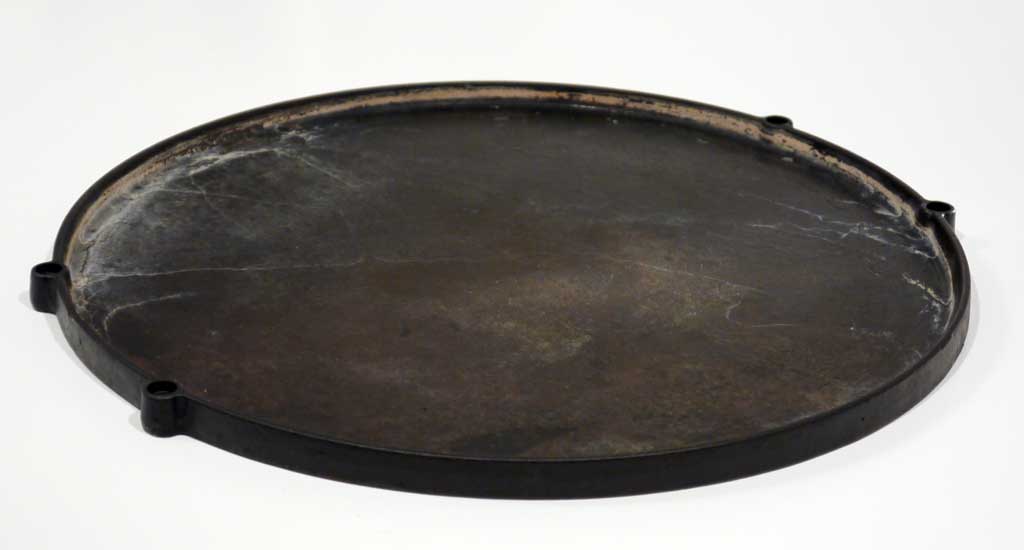
Square "baking stone" in hot rolled steel
8.5 kg 400 mm x 300 mm x 8 mm (15.7" x 11.8" x 0.31") hot rolled steel plate.
As happy as I was with my cast stone plate, I finally pulled myself together and got one made after my own measurements. The blacksmith looked a just little perplexed at first. But when I explained it, he found it quite amusing.
It is almost 3 times as heavy as the other stones. It is square and it's steel. It works very well. I set the oven to 300°C (570°F). I can bake a thin crust pizza in 4 minutes like this. Bread made with wet doughs gets a right proper kick of bottom heat as it raises up and gets lots of large air bubbles. An absolutely terrific solution that I can only recommend!
My blacksmith charged a few tens of dollars to plasma cut it and clean it. I washed it thoroughly and put cooking oil on it. Then I heated it in the oven. Which caused the oil to stick as a protective layer onto it. Just like you treat a cast iron pan. This prevents that anything sticks to it.
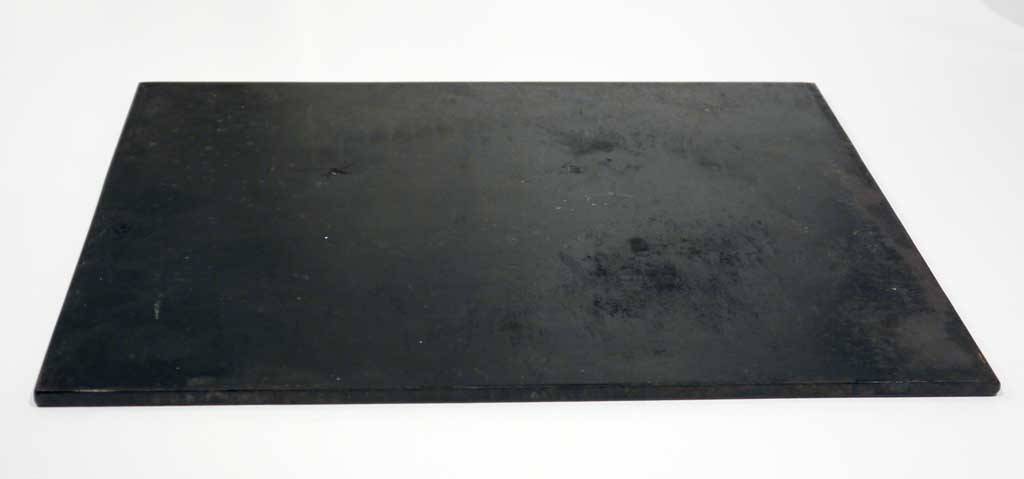
Conclusion
My square steel "stone" for baking on, combined with one of the round cast iron pans in the bottom, to generate steam, and possibly a third pizza stone a shelf above the square one, for storing and releasing radiant heat, makes it possible for me to make bread with totally professional results. That is whether I want to make pizza, rustic Italian bread, crisp bakers bread or French baguettes.
Even though a home oven cannot become as hot as a pro oven, the increased mass of steel in the oven can maintain an even temperature.
The steel also transfers heat so much faster and more efficiently that it does not matter much whether the air in the oven is hot or not.
A heated cast iron frying pan or pizza stone in the bottom of the oven is excellent for making massive amounts of steam without cooling the oven down too much.
So with this simple but effective set-up you can make all kinds of bread at a fully professional quality.
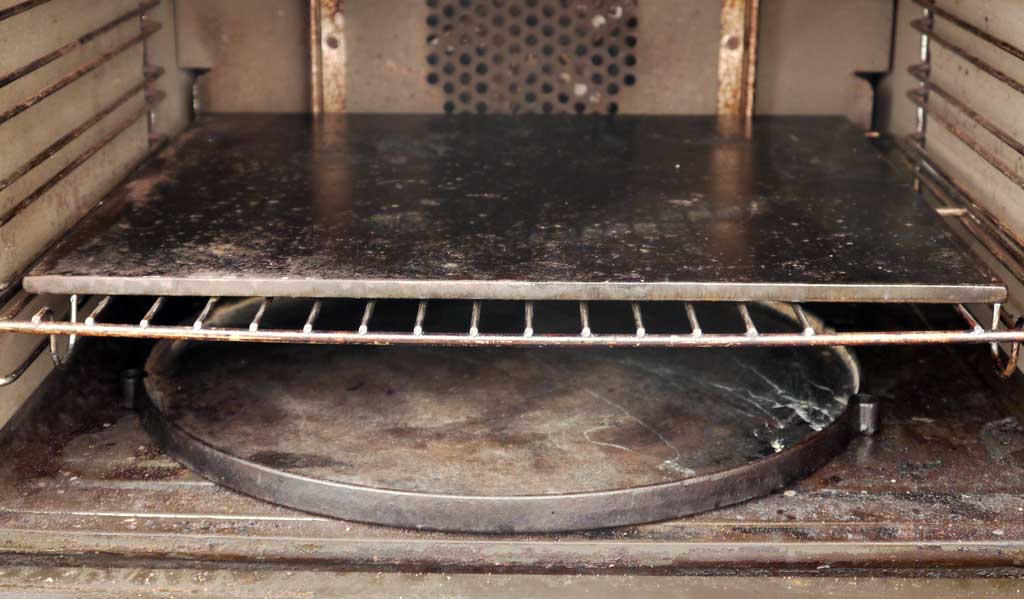
Max, can I just leave these stones in my oven all the time? I was wondering if it would make other items cook too rapidly and burn on the bottom?
I love your favorite rye bread recipe!
I leave mine in there all the time. It makes the oven heat up a bit slower, but the temperature is more stable when the temperature is reached.
My favorite is to use it in a convection oven. That usually prevents burning.
Thanks for the awesome information! I am based in Copenhagen and wondering where I might be able to also get a plasma cut hot rolled steel "baking stone" to my measurements? Thanks Max!
Fantastic analysis and summary! Thank you.
